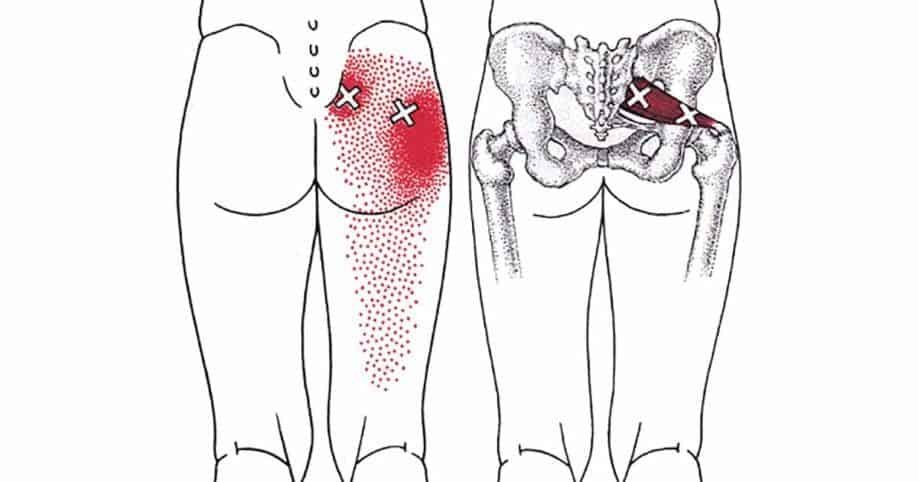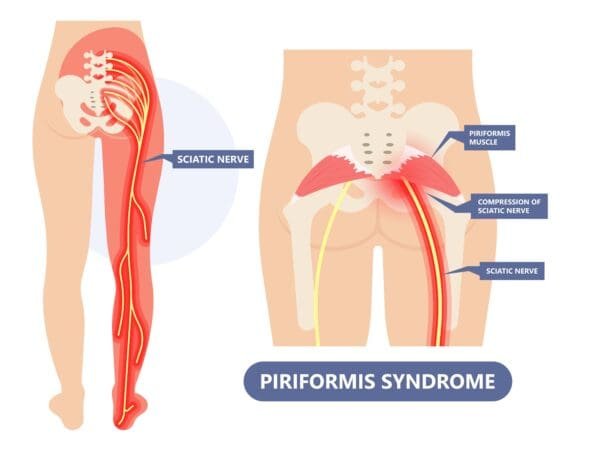8 Simple Piriformis Stretching Exercises You Can Do At Home

Have you ever experienced a nagging pain in your lower back or hip area that just won’t go away? Or maybe you’ve noticed tingling or numbness in your legs after sitting for too long. If so, you’re not alone. These issues are often related to a muscle called the piriformis.
The piriformis muscle is a small but mighty muscle located deep in the buttocks, near the top of the hip joint. When this muscle becomes tight or inflamed, it can cause a condition called piriformis syndrome, which can lead to pain, numbness, and difficulty moving freely.
In this post, we’ll dive into what the piriformis muscle is, what causes piriformis syndrome, and most importantly, we’ll share a variety of simple stretches and exercises that can help alleviate the discomfort and improve your mobility.
Whether you’re dealing with piriformis syndrome or just looking to improve your overall flexibility, these simple piriformis stretching exercises are easy to follow and can be done in the comfort of your own home.
What is the Piriformis Muscle?
You may have heard about biceps and triceps, but the piriformis muscle is surely not a muscle you hear about often.
This muscle lies over the sciatic nerve and allows movement of the hip, upper leg, and feet outward of the body. The piriformis muscle is connected to the front part of the sacrum with one end and to the bone at the base of the spine with the other.

It’s a pretty important muscle that keeps the sciatic nerve protected. It also keeps us balance in check beside helping with hip and leg movement.
If injured, our mobility and balance will suffer as a result. One of the most common conditions affecting the muscle is called piriformis syndrome and can be quite painful.
What’s Piriformis Syndrome?
This painful condition may be quite controversial for some doctors, but it really exists. In the past, it wasn’t even considered a problem and was misdiagnosed as sciatica.

However, lower back problems have later been found to cause the condition which affects around 8% of all people suffering from back pain. [1] [2]
The most common symptoms of the piriformis syndrome are numbness and tingling in the legs and severe pain in the lower back, legs, hips, and buttocks. An inflamed piriformis muscle can get quite painful and is equally difficult to treat.
Once diagnosed, the condition requires physical therapy and anti-inflammatory drugs. Severe cases may need medicine, although they are rare.
On the other hand, there are many simple stretches and exercises which can soothe the pain in your back and subdue the symptoms of piriformis syndrome.
The same stretches can help with rheumatoid arthritis, spinal stenosis, and knee pain, so make sure to check them out.
Deep Piriformis Stretches That Can Dull The Pain
The following piriformis stretches are great for subduing the pain and helping you move freely again. Try them all – they won’t take much of your free time and you will surely feel much better later.
- Supine Piriformis Stretch
- Standing Stretch
- Outer Hip Stretch
- Groin Stretch
- Inner Thigh Stretch
- Side Lying Clam
- Hip Extension
- Buttocks Piriformis Stretch
1. Supine Piriformis Stretch
- While lying on your back, raise one of your legs and bend the knee.
- Catch it with one of your hands and put your other hand on the raised heel.
- Now, gently bring the knee to your chest, then hold for 5 seconds.
- Relax for a few seconds before repeating the process again. Raise the duration of the stretch every day as you see fit.
- For a deeper stretch, bend both your knees and cross one of your legs over the other.
- Lift the bottom leg off the ground and bring it to your chest until you feel a stretch in the pelvis.
- Hold for 5-10 seconds, relax, and repeat.
2. Standing Stretch
This simple stretch will work on your glutes besides the piriformis.
- Stand next to a wall or with a chair in front of you.
- Grab it if you need for better stability. Now, bend one of your knees and cross that leg over the other.
- Lean forward with your chest towards the wall or chair while keeping your back straight.
- As soon as you feel a stretch in your glutes, stop.
- Hold for 30-45 seconds, then relax and repeat.
3. Outer Hip Stretch
- Lie on the floor on one side of your body and pull one knee to your chest.
- Feel the stretch in your hip and buttocks and hold for 30 seconds, then relax for 15.
- Repeat the stretch 3 times.
4. Groin Stretch
This stretch will work on your piriformis and long adductor.
- Sit on the ground and stretch your legs to the sides as far as you can.
- Put your hands in the middle between them and lower your chest to the ground as much as you can.
- Go until your elbows are on the ground, holding the stretch for 20 seconds.
- Relax for a minute and repeat again.
5. Inner Thigh Stretch\
Unlike the groin stretch, this exercise will work on your short adductors.
- Sit with your legs crossed on the ground and your back straight, putting your soles together.
- Put some pressure on your knees with your elbows until you feel a stretch.
- Lean forward and hold for 30 seconds, then relax and repeat again.
6. Side Lying Clam
This stretch will work on your sciatic nerve and piriformis muscle at the same time.
- Lie on one side of your body on the ground, then bend both your knees behind your back.
- Put your soles together and start raising the top knee slowly.
- When you feel a stretch, hold for a few seconds, then lower the knee.
- Try the stretch as many times as you can.
7. Quadruped Hip Extension
- Go down on all fours on the ground and raise one of your legs backward with your knee bent.
- Go as high as you can until you feel a stretch, raising your leg to the ceiling.
- Once you feel a stretch, hold for 5 seconds, then bring the leg back down.
- Repeat the stretch 10-15 times.
8. Buttocks Piriformis Stretch
This simple stretch will work on your piriformis and help you move freely again.
- Go down on all fours, putting the painful leg bent under your body.
- Extend the other leg behind your trunk while keeping your pelvis and back straight.
- Now, scoot your hips towards the floor and lean forward until you’re resting on your forearms.
- Hold the stretch for 30 seconds, then repeat it a few more times.
Bottom Line
If you’ve been dealing with piriformis syndrome or general tightness and discomfort in your hips, glutes, and lower back, give these stretches and exercises a try.
They are simple yet effective ways to help loosen up the piriformis muscle and alleviate symptoms. Remember to listen to your body and don’t push too hard – gentle, consistent stretching is key.
I’d love to hear if any of these stretches provided relief for you. Leave a comment below sharing your experience or ask any other questions you may have.
Don’t forget to share this article with anyone else who could benefit from learning about the piriformis muscle and how to keep it happy and healthy.
Read Next
